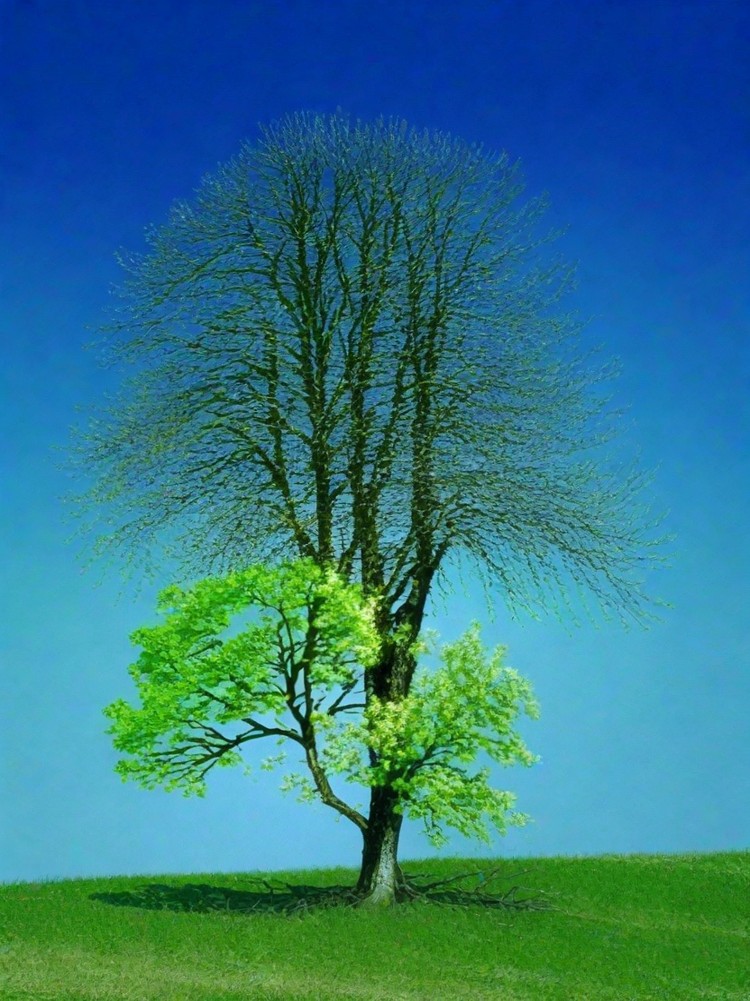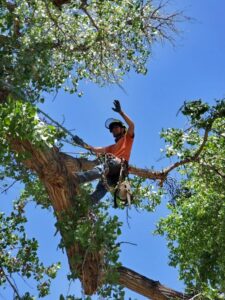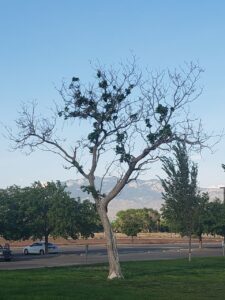A dying tree poses risks to the other plants around it, your property, and your family’s safety. Identifying the warning signs early can allow for interventions that may save the tree or, at least, prevent a dangerous situation. This guide will walk you through the signs of a dying tree.
Bare branches
A tree with no leaves or dead leaves could be a sign that the tree is sick or dying. A few dead branches on a tree are normal.
Here are some of the potential causes of bare branches:
Dormancy: During winter or the tree’s natural dormant season, it’s common for many species to shed their leaves. Bare branches in this case may be normal.
Disease or Pest Infestation: Diseases and pests can cause leaves to fall prematurely, leaving branches bare. The specific disease or pest will vary by location and tree species.
Water Stress: Both too much and too little water can cause leaf drop, resulting in bare branches. The soil should be moist but not soggy, and it must drain well.
Nutrient Deficiencies: Lack of essential nutrients can cause leaves to drop. An unhealthy, undernourished tree may show signs of stress through bare branches.
Poor Pruning Practices: Incorrect pruning or trimming at the wrong time of year can result in bare branches.
Environmental Stress: Extreme weather conditions such as excessive heat or cold, wind, or pollution can cause a tree to lose its leaves.
Root Damage: Damage to the roots, perhaps due to construction, compacted soil, or other underground disturbances, can disrupt the tree’s ability to take up nutrients and water, leading to bare branches.
Dieback or Decline: Progressive death of twigs, branches, shoots, or roots, starting at the tips is a sign of dieback, which may result from a combination of the above factors.
Brown or brittle bark
If the bark of a tree is brown and brittle or has cracks, it could be a sign that the tree is dying.
Here are 3 reasons your tree might have brown or brittle bark:
Disease: Certain fungal or bacterial diseases can cause the bark to become discolored or brittle. Diseases like cankers can infect the bark, causing it to dry out, crack, or become discolored.
Drought Stress: Insufficient water can cause the bark to become dry and brittle. Trees rely on water for nutrient transportation, and a lack of it can lead to stress that manifests in the bark. Extended periods of drought can severely impact a tree’s overall health.
Insect Infestation: Some pests, such as bark beetles, bore into the bark and feed on the tree’s inner layers. This infestation can cause the bark to become brittle, discolored, or even peel away from the trunk.
Deadwood
A few dead branches on a tree are perfectly normal. But, if a tree has an abundance of dead wood, it could indicate that it is a sick or dying tree.
Here are three likely causes of large amounts of deadwood on your tree:
Disease: Various fungal or bacterial diseases can infect the branches, leading to dieback and the accumulation of deadwood. These diseases can spread through the tree, causing significant structural weakness and even death if left untreated.
Drought or Water Stress: Lack of sufficient water can cause the branches to dry out and die, resulting in deadwood. If the roots cannot absorb enough moisture, or if there is a prolonged period of drought, branches may wither and die, adding to the accumulation of deadwood.
Poor Pruning Practices or Neglect: Inadequate or incorrect pruning can cause branches to die, leading to an abundance of deadwood. Conversely, failure to remove dead or dying branches in a timely manner allows the deadwood to accumulate. These neglected branches may host disease and become a physical danger if they fall.
Falling branches
Dead trees and branches can fall at any time, which can be a hazard to people and property. Seeing large amounts of fallen branches under your tree is a potential sign that your tree is dying.
Here are a few causes of falling branches:
Weather Conditions: Strong winds, heavy rain, snow, and ice can all put significant stress on branches, leading to breakage. Ice can be especially damaging, as it adds weight to the branches, which may then snap under pressure.
Poor Pruning Practices: Incorrect pruning can leave branches more vulnerable to breaking. Cutting in the wrong place or at the wrong time of year can create weak points in the branch, making it more susceptible to environmental stress.
Age and General Decline: Older branches, or those on a tree that’s in overall decline, might naturally become weak and fall. This could be due to natural aging or a gradual decline in the tree’s health for various reasons, including disease, poor soil conditions, or environmental stressors.
Mechanical Damage: Accidental damage from vehicles, machinery, or even animals can cause branches to break and fall. Sometimes the damage isn’t immediately apparent, and the branch may fall sometime after it has been weakened
Fungus or rot
If you see rot or fungus on the tree, it could be a sign that the tree is dying. These are the most common causes of fungus or rot in your trees:
Poor Drainage and Overwatering: Fungi thrive in moist environments, and soil that retains too much water creates an ideal breeding ground for fungal growth. Overwatering a tree, especially in soil with poor drainage, can lead to root rot and various fungal infections. Additionally, standing water on the trunk or branches can promote the growth of fungi that cause wood rot.
Wounds and Injuries: Any damage to the bark, whether from improper pruning, mechanical injuries (e.g., lawnmowers, construction equipment), or weather-related damage, can create an entry point for fungal spores. Once inside the tree, the fungus can proliferate and cause decay in the heartwood, leading to structural weakness and, eventually, rot.
Environmental Stress: Trees weakened by environmental factors such as drought, pollution, extreme temperatures, or nutrient deficiencies are more susceptible to fungal infections. A stressed tree is less able to fend off diseases, and this compromised immune response allows fungi to gain a foothold. Once established, fungal infections can spread, leading to rot and further weakening the tree.
Prevention and early detection are key to managing fungal infections and rot in trees. Regular inspections, proper watering practices, careful pruning, and attention to the tree’s overall health can prevent many issues. If signs of fungus or rot are detected, consulting with a professional arborist or tree care specialist is advisable, as they can provide proper diagnosis and treatment.
Leaning
If a tree is leaning more than usual, that is a red flag. Your tree is probably leaning because:
- Root Instability: The roots may be weak or damaged due to disease, rot, or construction activity near the root zone. This instability in the root system can cause the tree to lean, particularly if strong winds or heavy rain exacerbate the problem.
- Uneven Growth or Weight Distribution: If one side of the tree has denser foliage or more massive limbs, it can create an imbalance, causing the tree to lean in that direction. This can be a result of uneven sunlight, poor pruning practices, or natural growth tendencies of the particular tree species.
- Soil Erosion or Shift: Changes in the soil level around the base of the tree, whether due to erosion, a slope, or other landscape alterations, can cause the tree to lean. The erosion or shift in soil may undermine the support on one side of the tree, leading it to lean gradually over time.
A leaning tree can be a significant concern, as it may indicate structural instability that could lead to the tree falling. It’s wise to consult with a professional arborist or tree care specialist to assess the situation and determine whether the tree can be stabilized or if removal is the best course of action.

The most likely cause of a dying tree
I’m sure you noticed a few common patterns between all of these signs that your tree might be dying. The most likely cause of a dying tree is because of water stress. In most cases, signs of death in the tree are from lack of water. You’ll often see the tips of the top branches beginning to die when your tree has too little water.
On the other hand, in wetter climates, sometimes overwatering can cause fungus and other diseases to kill a tree off quickly. Although, overwatering is much harder to accomplish in the high desert of New Mexico.
Conclusion
It’s important to note that the signs listed above do not always mean the tree is dying, but they indicate a problem. If you notice any of these signs, it’s recommended to consult with an arborist or tree care professional to determine the appropriate course of action. Contact us using our form here, and we’ll give you a roadmap for returning your trees to good health!




